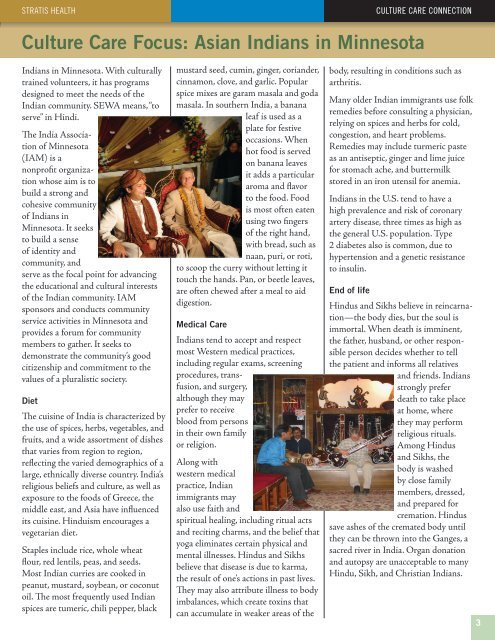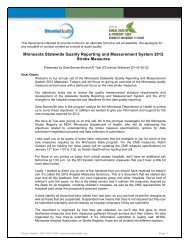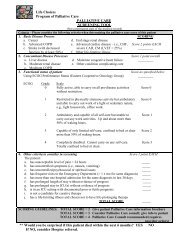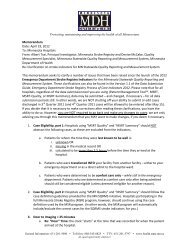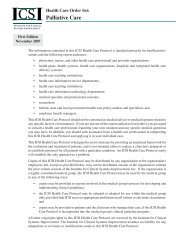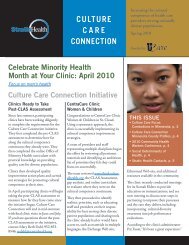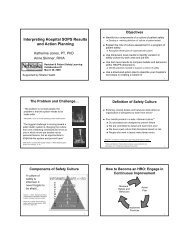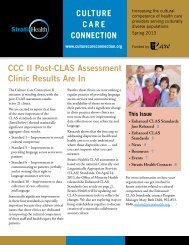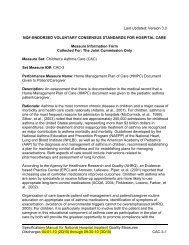Culture Care ConneCtion - Stratis Health
Culture Care ConneCtion - Stratis Health
Culture Care ConneCtion - Stratis Health
You also want an ePaper? Increase the reach of your titles
YUMPU automatically turns print PDFs into web optimized ePapers that Google loves.
StratiS HealtH <strong>Culture</strong> <strong>Care</strong> Quality <strong>ConneCtion</strong><br />
update<br />
<strong>Culture</strong> <strong>Care</strong> Focus: Asian Indians in Minnesota<br />
Indians in Minnesota. With culturally<br />
trained volunteers, it has programs<br />
designed to meet the needs of the<br />
Indian community. SEWA means, “to<br />
serve” in Hindi.<br />
The India Association<br />
of Minnesota<br />
(IAM) is a<br />
nonprofit organization<br />
whose aim is to<br />
build a strong and<br />
cohesive community<br />
of Indians in<br />
Minnesota. It seeks<br />
to build a sense<br />
of identity and<br />
community, and<br />
serve as the focal point for advancing<br />
the educational and cultural interests<br />
of the Indian community. IAM<br />
sponsors and conducts community<br />
service activities in Minnesota and<br />
provides a forum for community<br />
members to gather. It seeks to<br />
demonstrate the community’s good<br />
citizenship and commitment to the<br />
values of a pluralistic society.<br />
Diet<br />
The cuisine of India is characterized by<br />
the use of spices, herbs, vegetables, and<br />
fruits, and a wide assortment of dishes<br />
that varies from region to region,<br />
reflecting the varied demographics of a<br />
large, ethnically diverse country. India’s<br />
religious beliefs and culture, as well as<br />
exposure to the foods of Greece, the<br />
middle east, and Asia have influenced<br />
its cuisine. Hinduism encourages a<br />
vegetarian diet.<br />
Staples include rice, whole wheat<br />
flour, red lentils, peas, and seeds.<br />
Most Indian curries are cooked in<br />
peanut, mustard, soybean, or coconut<br />
oil. The most frequently used Indian<br />
spices are tumeric, chili pepper, black<br />
mustard seed, cumin, ginger, coriander,<br />
cinnamon, clove, and garlic. Popular<br />
spice mixes are garam masala and goda<br />
masala. In southern India, a banana<br />
leaf is used as a<br />
plate for festive<br />
occasions. When<br />
hot food is served<br />
on banana leaves<br />
it adds a particular<br />
aroma and flavor<br />
to the food. Food<br />
is most often eaten<br />
using two fingers<br />
of the right hand,<br />
with bread, such as<br />
naan, puri, or roti,<br />
to scoop the curry without letting it<br />
touch the hands. Pan, or beetle leaves,<br />
are often chewed after a meal to aid<br />
digestion.<br />
Medical <strong>Care</strong><br />
Indians tend to accept and respect<br />
most Western medical practices,<br />
including regular exams, screening<br />
procedures, transfusion,<br />
and surgery,<br />
although they may<br />
prefer to receive<br />
blood from persons<br />
in their own family<br />
or religion.<br />
Along with<br />
western medical<br />
practice, Indian<br />
immigrants may<br />
also use faith and<br />
spiritual healing, including ritual acts<br />
and reciting charms, and the belief that<br />
yoga eliminates certain physical and<br />
mental illnesses. Hindus and Sikhs<br />
believe that disease is due to karma,<br />
the result of one’s actions in past lives.<br />
They may also attribute illness to body<br />
imbalances, which create toxins that<br />
can accumulate in weaker areas of the<br />
body, resulting in conditions such as<br />
arthritis.<br />
Many older Indian immigrants use folk<br />
remedies before consulting a physician,<br />
relying on spices and herbs for cold,<br />
congestion, and heart problems.<br />
Remedies may include turmeric paste<br />
as an antiseptic, ginger and lime juice<br />
for stomach ache, and buttermilk<br />
stored in an iron utensil for anemia.<br />
Indians in the U.S. tend to have a<br />
high prevalence and risk of coronary<br />
artery disease, three times as high as<br />
the general U.S. population. Type<br />
2 diabetes also is common, due to<br />
hypertension and a genetic resistance<br />
to insulin.<br />
end of life<br />
Hindus and Sikhs believe in reincarnation—the<br />
body dies, but the soul is<br />
immortal. When death is imminent,<br />
the father, husband, or other responsible<br />
person decides whether to tell<br />
the patient and informs all relatives<br />
and friends. Indians<br />
strongly prefer<br />
death to take place<br />
at home, where<br />
they may perform<br />
religious rituals.<br />
Among Hindus<br />
and Sikhs, the<br />
body is washed<br />
by close family<br />
members, dressed,<br />
and prepared for<br />
cremation. Hindus<br />
save ashes of the cremated body until<br />
they can be thrown into the Ganges, a<br />
sacred river in India. Organ donation<br />
and autopsy are unacceptable to many<br />
Hindu, Sikh, and Christian Indians.


